|
|

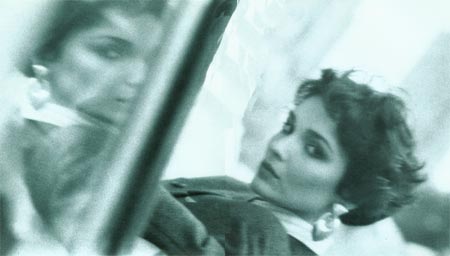 CHAPTER 6 Getting The Cut You WantBecause I have such respect for hair and its inherent beauty, I am very cautious about When I cut hair, therefore, I am hardly dealing only with what is growing on someone's head. Instead, I must keep in mind the sum total of my experience of the person I am cutting--height, weight, life-style, face shape, bone structure, hair quality, condition, color, and texture. And when I work with a woman (because I do cut men's hair, too), I must be just that much more sensitive and careful: there are more variables. For me, cutting a woman's hair is not too far removed from making up her face. I must keep the same things in mind--natural coloring and how to enhance it, how to highlight beautiful cranial and facial structure and direct attention away from any less-than-perfect feature, how to work with the texture of the hair, how to play down the effects of aging, and how to bring the whole presentation into focus through attention to proportion and balance.
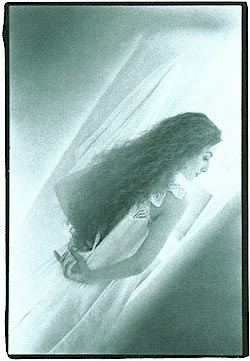 It's easy for hair to look good in the salon. But you can't tell whether you have a really good cut until after you leave the salon, get home, live with the new style for a couple of days, and then--this is the acid test--wash it and see if it falls into place. The cut that was spectacular in the salon may be unrecognizable when it is left to fend for itself, away from a solicitous hairdresser's ministrations. Here are five ways to check out your haircut. (Your hairdresser should be doing the same five things while s/he cuts.)
1
While it is still wet, check the layering...if your hair is layered. If you look at the back and sides with a mirror, you will be able to see if the layering is even.
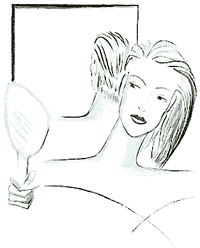 2
Take hold of the two strips of hair closest to your face on either side of it and pull them toward the chin. You can then see if they are the same length.
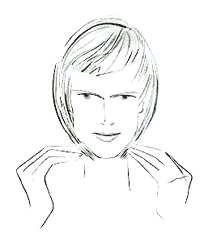 3
Part your hair from either side and then down the middle. Hair should fall into line regardless of where it is parted. There shouldn't be any "rogue" strands. 4
Let your hair dry naturally, pulling it from roots to ends to encourage the shape to return. (Do this gently at first, and then more vigorously.) Push it into place with your fingers. The line should fall in easily. 5
Grab your hair behind each ear and "scrunch" it. You should feel the same amount of bulk in each hand. 6
Finally, your style should be self-supporting, with closeness, volume, or height cut right in so that you don't have to create it with the aforementioned styling aids.
Don't just curse your luck and vow never to return to the person who committed the crime; you owe it to the salon and to yourself to go back and tell them you're not pleased. You can reasonably expect to have any mistake corrected. There's always the chance they will make it worse rather than better. In that case there is little to do but let it grow out. (As serious as it may seem at the time, a sense of humor goes a long way toward repairing the disaster of a bad cut.) And next time go to a salon you have investigated more thoroughly.
In general, once you have had your hair cut sensitively, your cut should last anywhere from six weeks to three months, depending on the rate at which your hair grows. More important, it should keep the shape it was cut in; although hair does grow unevenly (especially in the back), a good hairdresser should allow for the "grow in." For some reason no one has ever been able to explain to me, it is my observation that the shape seems to come back strongly every three weeks or so in a kind of cycle. When do you stop waiting for the shape to come back and get yourself to your hairdresser? When you find yourself fooling with your hair, having to comb, brush, or minister to it constantly to keep it looking fine. A push of the fingers and a shake of the head should be enough to do it, if it is not in need of another trim. It is also important to keep a close watch on the condition of your hair. If your hair begins to look frayed, it needs to be cut before the damage spreads up the hair shaft. (This is not unlike plucking dead leaves off a plant to give the new growth a chance. You simply must cut damage off.) A change in the weather or the way you care for your hair (too much brushing in the winter, for instance), or exposure to sun or wind, can cause a lot of damage from one cut to the next. You may also have had your hair processed--either permed or colored--and need to cut off damage from the processing itself. (This damage may not be immediately obvious after it has been done.)
There is one other situation in which frequent cutting is advisable, and that is when the hair is thinning. Although this is often thought of as an exclusively male problem, we are all susceptible to thinning hair as we age--especially at the crown. Hair that is thinning, then, needs special attention in two ways: cosmetically, to disguise the thinning and keep the hair "light" so that it appears to have more volume; and therapeutically, to keep the increasingly fragile hair from breaking and to encourage growth. There is a fairly drastic technique I use...usually with men: if you look carefully at a hair growing in a thinning area (the hairline, for instance), you will see that the hair shaft gets more delicate looking about half an inch from the scalp. Cutting the hair just at that point--where the shaft itself gets thinner--seems to strengthen the hair, and I have been very pleased to note the apparent inhibition of the thinning process with this method.
A drastic change in hairstyle or length is not irrevocable, of course, and the risk-taking involved is--I think--character building in itself. The worst that can happen is that you don't like the style and must wait for it to recover its length or shape. Even slow-growing hair gains one-half inch a month, and fast-growing hair can gain almost an inch in the same amount of time. However, chances are you may even--like that favorite client of mine in part one--discover something wonderful about yourself with your new look, something positively transforming.
Hair that is longer than shoulder length is not very pretty in and of itself unless (1) you have a great deal of it; (2) it is superbly styled; and (3) it is very healthy. Long hair tends to get flattened by its own weight and look droopy and dead; natural waves are "pulled out" by the length. And all too often the hair is blunt cut, probably in some misguided commitment to the retention of every last inch, adding to its flabbiness. Hair like this, and especially hair that goes past the shoulder, doesn't move with the head and makes the whole face and body look less dynamic and alive. As a result, the very advantage sought with long hair--the illusion of volume, of lots of bouncy, shiny hair--is lost. And because a woman doesn't know where that elusive volume has gone to, she thinks she must grow her hair longer in search of it. Inevitably, the longer it gets, the worse it looks, the more it drags down the face--and body--and finally, the older it makes her seem.
Volume is a very contemporary notion. It gives longer hair dimension and interest and frames the face. Volume can also help to balance your whole look, offsetting heavy hips, thighs, or buttocks, or drawing attention up and away from a large bust or a general weight problem. Ironically, this is precisely what most long hair fails to do, simply because, as it grows past the shoulder, it draws the eye downward, to the body, making a woman seem shorter and heavier. Long hair also interferes with the shoulder and collar line, softening that high horizontal line and in that softening "rounding" the whole body and making it seem dumpier. And if you like good clothes, you will find their impact dulled with hair that falls over the collar and shoulder area. (You never see models during a fashion show allowing their hair to interfere with the line of the designer garments. Runway models usually wear their hair short and sleek--or up and sleek--unless the designer is looking for a particular effect.)
There are a number of ways to achieve volume. I approve of three of them: cutting volume in, drying it in (which you can do with finger- or blow-drying), and-if your hair is very straight and/or fine-a perm or bodywave. What I don't approve of on a daily basis (unless you are going for a special, high-image look) is the manipulation of hair by means of setting, teasing, and sprays. It takes a lot of your valuable time, the look itself is passť, and it doesn't help your hair's health one bit.
I do something I call "sculpture cutting," which requires following the hair's natural lines and cutting so that those lines--or waves--are expressed. Sculpture cutting is really a direct outgrowth of my interest in natural pattern and the organic "soul" of an object. This technique not only results in greater volume; it also gives the hair movement, expression, and life.
Some of my clients have been astonished to find that their "straight" hair is actually quite wavy once those waves have been cut in. Even if there are no waves per se, each head of hair has its own "movement": it must, as all hair grows in a circular pattern from the crown of the head. (Take a look at the crown of your head with the aid of a couple of mirrors. It will help you to understand why your hair does what it does.) The growth pattern may be so pronounced that hair on one side of the face grows directly away from it, while hair on the other side grows straight toward it. And the shorter your hair is, the more these growth patterns will determine the look of the final style, as there are fewer ways in which to disguise direction of growth or cowlicks...which are smaller whorls-sort of "hair whirlpools"--that can turn up anywhere on the head and can make a particular hairstyle impossible to maintain easily. Sculpture cutting is especially effective around the face, and it is here that the hairdresser must be most skillful in making his or her judgments about what must be done. A good, sensitive sculpture cut can light up a face, drop years, and set the tone for the rest of the head and body.
I say "shorter hair" in preference to "short hair" because hair need not be what is thought of as short to have all the advantages of short hair. In fact, a good, well-thought-out, medium-length haircut can give you both looks--the illusion of length and volume and the neatness and impression of cropped hair--with different stylings. Almost no one--especially the busy people I deal with--has time anymore to contend with a weekly visit to the hairdresser. Women are on the go--they travel, work out, swim, and play sports regularly-and they need hair that complements their life-style, dries easily, and falls into place with a shake of the head and a lift of the fingers. They also need a cut that will look as good in the sixth week as in the first, so hair cannot be cut into a "style" but must be shaped with an eye to its organic whole. Everyone is impatient with having to fool with hair for one second more than necessary. Short hair--even very short hair--is glamorous, and new....And shorter hair--with a good cut--is infinitely more versatile (to say nothing of being much easier to take care of) than longer hair. It is also my sense that women are beginning to prefer the look of shorter hair. Shorter hair poses a constant challenge to reexpression; running fingers through hair rearranges it continuously. And recently as women have become more comfortable with their sexuality and their own bodies, they have wanted to express themselves in every area of their lives...and in every aspect of their looks. What's more--to be quite blunt--a modern lifestyle dictates that hair must look as good getting out of bed as it did getting in. A woman wants to be ready to go instantly...and always.
There is a certain amount of judgment to this, of course...but judgment is what you are paying your hairdresser for. S/he will have to decide whether a given length will work for your hair...and your face, and your body...and s/he will need your input to know about your life and what you need-and expect-from your hair.
Hair should be short enough to give your whole look some lift, but still long enough to be versatile. (My general rule is to keep it a little shorter than chin length, as this shows off the neck and face to advantage.) In many ways, shorter hair is almost like a fashion accessory: it usually makes a clearer statement, is more highly and/or individually styled, and is much more definitely "worn" than longer hair.
Yes ma'am, you can have it both ways: it is entirely possible to have the advantages of short hair and the illusion of long. There are two effective ways to do this:
So you see you do have nearly endless options in juggling between long and short.
A shorter cut will bring out your hairdresser's talent...or lack of it. Short hair is much more unforgiving, not only because there is less margin for error (a mistake will show up in direct proportion to how short the hair is), but because it means that the hairdresser must really understand your hair...understand the way it grows, understand its type (hair that is only wavy when it is long may be quite curly when it is short), and pay close attention to the shape of your face and your head. Whether the hair next to your face grows forward or backward becomes critical when it is only an inch long; cowlicks you never knew you had may suddenly appear when the weight that has kept them flat is cut off, or some asymmetry of hair growth may show up--one you were never aware of because you had enough hair to hide it.
I personally think the old blunt cut looks hard and heavy; it's difficult to achieve the fullness most women seek with a cut that This cutting technique is used to vary the weight of the hair--to soften a look (especially at its edges) or to lighten it--so that the ends are released and have more vitality. It is achieved by thinning the lower portion of the hair (in some places only the very ends) almost strand by strand, feathering it. This texture can always be smoothed back with a gel or mousse if you want a more classical or severe look, but for day-to-day wear, texturizing can give a real lift.
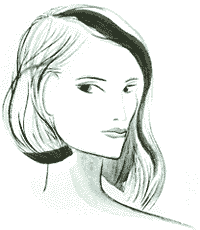 One of the current trends in hairstyling is contrasts in hair--contrasts of texture, length, even color. Texturizing can accomplish this kind of contrast as an integral element of the cut, so it is often the first thing I suggest for someone who really wants a new look. A little experimentation can pay off in some lovely--and often very interesting--effects.
Undercutting is another method of making hair seem livelier and fuller than it is on its own: it creates an illusion of more body than the hair actually has by shortening the layers underneath--under the style that is seen-so that they support the top layers.
Undercutting involves snipping short points of hair near the root to hold the rest of the hair up and out. Obviously this has to be done very carefully, or you can look like the mice have been at you, but skillfully accomplished, it can make you look as if you have a lot more hair--and your hair has a lot more bounce--than you (or your hair) really do.
Layering is what they used to do to "thin" hair so that it was more manageable. (All it really succeeded in doing, I think, was to make it look scrappy growing out.)
Now layering is a highly refined technique for giving hair texture, versatility, and movement without the loss of a clean line. Layering solves problems that were once addressed with perms, because--when done on hair that has the least bit of body or wave--it delivers fullness and curves without damage and without grow-out. Layering essentially creates tiers of hair around the shape of the head. I give special attention to the problem of blending layers into each other so that the grow-out period is graceful, and the layers "reweave" themselves as they get longer. This is different from sculpture cutting, as it is primarily a volume and shaping technique rather than one that concerns itself with hair's line and wave.
Probably half of all women classify their hair as fine and/or limp. (The other half sees theirs as too unruly.) If you have tried everything in the way of cutting in some body and movement, and your hair still lies there as if it died three days ago, it may be that the only cure is either a body wave for lift and volume or a real perm--of the full head or just the crown, top, or front (which is where the hair is usually finest and flattest and where it may also be thinnest because it gets most abuse). Alternately, you might consider waving just the undersections, so that they can support the top layers of hair, which will remain relatively straight. This technique is called root perming. Here are some other tricks you can use to cope with fine or limp hair:
Most people with curly hair don't seem to realize how lucky they really are; for some reason, they are least likely to want to accept their hair for what it is and live with its natural state. There's a nasty rumor going around that curly hair is much easier to cut than straight hair because the curl will hide any mistakes. This may be true right after a cut, but just wait until the hair begins to grow in! Straight hair is much more forgiving during the grow-in period than curly hair, which can get terribly wild looking if the cut wasn't good to begin with. But the myth persists, and lots of curlies rarely get the kind of cut they deserve. The biggest error made in cutting hair is to try to make it all one length; curly hair should be layered... and if it's just wavy, sculpture cut. Length must also be played off against degree of curl, so that the head comes out looking balanced both in length and curl.
There is one thing I feel very confident of, it is this: after a woman first comes to me, she will leave my salon looking ten years younger...and ten years better. There is no question in my mind that the most youthful look is a natural one...which means not trying to cover up signs of your age; you're not fooling anyone. And a hairstyle of your youth--or alternatively, one of those I think of as "old lady hair" (set, teased, and sprayed)--doesn't serve you well, either.
There is so much a woman can do to play down the effects of aging--on her hair and her facial features! All too often, however, she depends on heavy makeup, hair coloring, perms, and other artifice to give the impression of youth. (This reminds me of the hairpieces some balding men wear. People remark, "Gee, that's a great-looking hairpiece ... very natural," when the whole idea is not to notice it to begin with!) Here are some of my principles for looking your best--no matter what your age.
I'm all for self-sufficiency; as I said before, that is what this book is at least partly about. However, it isn't so easy to be self-sufficient in the matter of cutting hair. It would be rare for you to be able to see what I see when I am cutting, and although a judicious trim here or there for a wisp that threatens to get out of hand is appropriate, I think it is best to leave the monthly or bimonthly hair overhauls to a professional. What you can take care of yourself, however, are your bangs.
I love bangs. They soften a face, add interest to good features, emphasize eyes and cheekbones, and look youthful. They can also shorten a long face or slim a wide one, depending on how they are cut. Because there is so much bangs can do, they should initially be cut by a stylist so that s/he can decide whether they ought to be short or long; curved, straight, or tapered; full, half, or "wispy." Then, after they have been cut professionally, you can keep up with them at home (they will probably need to be looked after every two to three weeks) between salon appointments. I think it's a shame to have to run to your hairdresser just to have your bangs trimmed when you can do it so easily yourself...if you pay attention and are careful. Practice makes perfect.
When you get ready to trim, use the smallest-size (five inches--and without that little finger guard) haircutting scissors you can find, and make certain that they are sharp or they'll just push the hair around rather than cutting it cleanly. Always cut with the ring finger and thumb for the best dexterity. After washing, towel-drying, and "pushing in" your hairstyle, size up your cutting needs a final time before taking the plunge (that first snip is always the hardest). You won't want to be cutting off more than one-quarter inch when you do this. Occasionally someone will get carried away in the search for the perfect bang; then it's like cutting table legs: you never get them even, but they do get shorter and shorter. Remember, the length can vary just because of cowlicks, odd growth patterns, or the different ways your hair falls. Reassess when your hair is dry, and clean up any errant hairs. | ||||||||||||